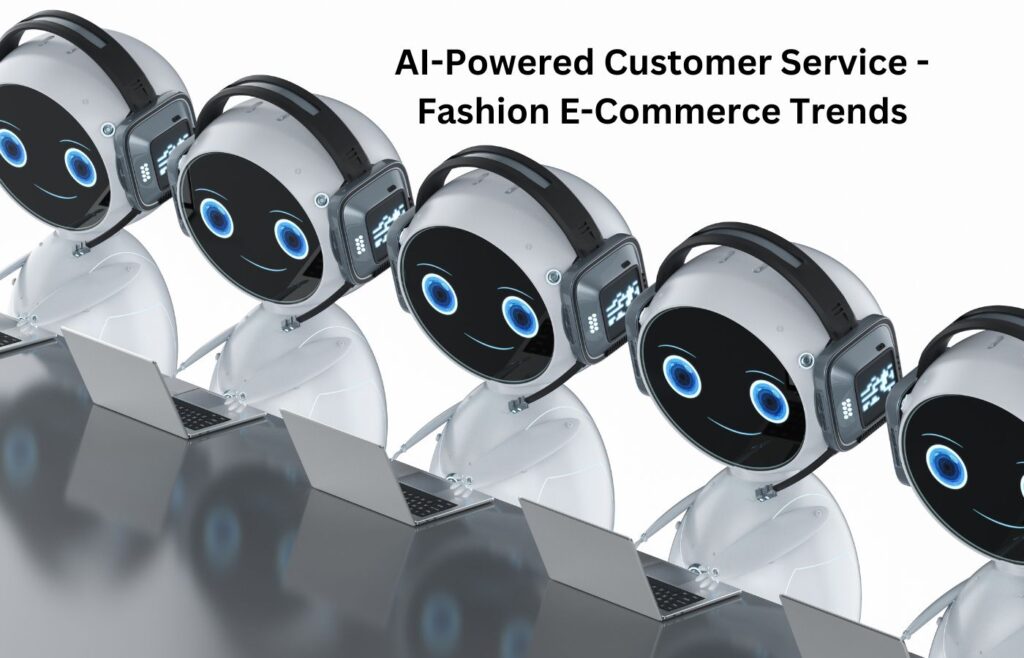Introduction – Fashion E-Commerce Trends
2024 promises to be an unprecedented year in fashion e-commerce trends, marked by technological innovations, changing consumer behaviors, and shifting industry dynamics. As technology revolutionizes how consumers access fashion online retail stores, several vital trends should shape how online retail in the fashion industry evolves over the coming decade.
2024 will witness an increased emphasis on personalization and customization. Fashion brands will use sophisticated data analytics and AI-powered algorithms to deliver tailored shopping experiences, tailored specifically to individual preferences and needs. This hyper-personalization will not only increase customer satisfaction but also boost engagement rates and conversion rates.
Sustainability will remain at the core of fashion e-commerce trends in 2024. Consumers increasingly require transparency and accountability from brands, leading them towards eco-friendly materials, ethical sourcing practices, and carbon-neutral logistics—practices that create lasting consumer connections while giving an edge in competition with competitors. Brands that embrace sustainability with integrity will build stronger bonds with conscientious shoppers while increasing market competitiveness.
Emerging technologies such as augmented reality (AR) and virtual reality are revolutionizing the online shopping experience, offering consumers immersive ways to experience fashion products before purchasing. Social commerce integration, mobile-first strategies, and influencer and influencer-led collaborations also shape fashion e-commerce trends by offering brands new ways to engage consumers while driving growth within digital channels.
In this article, we will delve deeper into these trends and examine their effect on fashion e-commerce trends in 2024, noting opportunities and challenges faced by brands in an ever-evolving and dynamic market.
Personalization and Customization – Fashion E-Commerce Trends

Personalization and customization will be integral in shaping fashion e-commerce in 2024, revolutionizing how brands engage with consumers to provide unforgettable shopping experiences.
Personalization in fashion e-commerce trends refers to tailoring product offerings, recommendations, and marketing messages to individual preferences and behaviors. Brands use advanced data analytics and AI algorithms to gather customer information such as browsing history, purchase patterns, and style preferences to personalize product recommendations, tailor services to each consumer, and deliver targeted content that resonates with each consumer.
Customization goes one step further by allowing consumers to co-create products according to their tastes and preferences. From selecting fabric colors and patterns to personalizing monograms or embellishments, customization will enable consumers to express themselves uniquely through fashion products they co-create with brands using product configurators or virtual design tools, giving them ownership in creating fashion items they may make themselves.
2024 is projected to see personalized and tailored fashion offerings becoming increasingly prevalent. These offerings are expected to create customer engagement, build brand loyalty, and improve the shopping experience online. By adapting these trends into their offerings, brands can strengthen their connections with consumers while differentiating themselves in an increasingly competitive marketplace.
Sustainability and Ethical Practices – Fashion E-Commerce Trends

Sustainability and ethical practices have emerged as essential tenets of fashion e-commerce trends in 2024, reflecting consumer demand for greater transparency, accountability, and responsible business practices within the industry.
Sustainability within fashion e-commerce trends encompasses multiple initiatives to minimize environmental impact throughout its supply chains, from using eco-friendly materials such as organic cotton or recycled fibers, adopting water and energy-saving manufacturing processes, and employing circular economy principles to minimize waste while increasing product longevity. Brands also prioritize ethical labor practices within their supply chains that ensure fair wages, safe working conditions, and respect for human rights.
Consumers increasingly prefer sustainable fashion options, prompting brands to incorporate sustainability into their core business strategies. E-commerce platforms now feature sustainable brands, label eco-friendly products with eco-labels, and provide transparency regarding sourcing and manufacturing practices. Brands that authentically embrace sustainability satisfy consumer expectations and have positive environmental and social effects.
2024 will see the rise of fashion e-commerce trends ‘s commitment to sustainability and ethical practices as an industry. Brands prioritizing sustainability will benefit by appealing to environmentally aware customers while building trust through transparent and responsible business practices. By adopting sustainability into fashion e-commerce practices, fashion e-commerce trends is moving toward becoming a more ethical industry with less of an impactful future.
Augmented Reality (AR) and Virtual Reality (VR) – Fashion E-Commerce Trends

Augmented Reality (AR), Virtual Reality VR, and virtual reality technologies are revolutionizing fashion e-commerce trends, providing consumers with engaging ways to interact with products before making purchasing decisions.
AR-powered virtual reality solutions became more widely utilized by shoppers in 2024, allowing them to better visualize how clothing and accessories will look and fit on their bodies.
Utilizing advanced computer vision and image recognition algorithms, virtual reality will enable consumers to virtually “try on” garments from the convenience of their home without risking physical contact with garments or trying them on in person first.
Virtual reality builds confidence when purchasing apparel online by offering more accurate representations of fit and style, ultimately decreasing uncertainty about purchasing apparel online.
Fashion brands are adopting AR and virtual reality features into their e-commerce platforms to boost engagement and conversion rates and reduce returns.
By employing these technologies, brands create personalized online and offline shopping experiences while offering consumers more interactive journeys. 2024 will likely see further advances in AR applications within fashion e-commerce trends that blur digital and physical retail environments while revolutionizing how customers discover and shop fashion online.
Social Commerce Integration – Fashion E-Commerce Trends

Through the utilization of social media platforms as sales channels and the generation of direct conversions based on social interactions, social commerce integration is utterly altering the fashion e-commerce environment.
2024 is a year in which social media and online shopping are fast colliding. Fashion firms are making use of social media platforms such as Instagram, TikTok, and Pinterest to engage with customers and provide them with a smooth buying experience. Shoppable posts, live shopping events, influencer partnerships, and influencer reviews are some of the techniques that fashion firms have implemented to involve customers directly within their social feeds and to make it easier for them to make purchases.
As a means of capitalizing on user-generated content and endorsements from influencers to boost engagement and conversions, brands are investing in social commerce integration to take advantage of the engaging and immersive nature of social media.
Creating seamless buying experiences while also tapping into the power of online communities is something that marketers can accomplish by integrating e-commerce functionalities into social platforms.
In the year 2024, there will be a wider integration of social commerce with fashion e-commerce trends. Brands will utilize innovative features and collaborations to improve their interactions with their customers and exploit revenue sources.
Through the utilization of social media, social commerce represents a revolutionary change in the manner in which brands interact with their target customers. media as an essential sales driver and amplifier in an increasingly digital and social marketplace.
Mobile-First Strategies – Fashion E-Commerce Trends

Mobile-first strategies will become even more crucial for fashion e-commerce trends in 2024 as mobile devices dominate consumer shopping habits and online behavior.
Given the increasing popularity of mobile shopping, fashion brands are prioritizing mobile optimization in all aspects of their e-commerce operations. This involves adopting responsive web design, customizing user interfaces for smaller screens, optimizing load speeds for mobile devices, and offering intuitive navigation experiences on these devices.
Mobile-first strategies include developing dedicated apps with enhanced features like one-click checkouts, personalized recommendations, and seamless integration into mobile wallets.
Fashion brands that adopt mobile-first strategies can take advantage of mobile accessibility to provide consumers with a smooth shopping experience on the go. Mobile optimization not only enhances user experience but also drives conversion rates and reduces bounce rates, resulting in improved customer satisfaction and brand loyalty.
By 2024, we anticipate fashion e-commerce platforms will increase their investment in mobile-first strategies, utilizing data-driven insights to optimize mobile experiences and capitalize on mobile shopping trends.
Brands that adopt such approaches will be well-positioned to compete successfully in an increasingly mobile-centric marketplace by meeting consumer preferences and serving modern consumer behaviors who rely heavily on smartphones for online shopping and digital interactions.
Subscription and Rental Services – Fashion E-Commerce Trends

The use of subscription and rental services as cost-cutting alternatives to traditional retail models is becoming increasingly popular among consumers who shop for fashion online.
In the year 2024, fashion firms are embracing subscription and rental models to cater to the shifting preferences of consumers and to encourage the implementation of circular economy initiatives.
Subscription services provide access to curated collections of clothing and accessories at a predetermined monthly fee. Rental services provide access to high-end fashion items for special events or everyday wear without the commitment of ownership, thereby reducing the negative impact on the environment while simultaneously encouraging sustainable consumption practices.
When it comes to fashion, firms that offer subscription and rental services have the opportunity to reach a demographic that prioritizes access over ownership while also emphasizing sustainability.
By utilizing subscription and rental services, businesses can make optimal use of their inventory, reduce the amount of extra stock they have, and cultivate long-term relationships with their customers through the generation of recurring revenue streams.
It is anticipated that the spread of subscription and rental services within the fashion e-commerce industry will continue in 2024, with firms continuing to innovate their offers to satisfy a wide range of consumer wants and preferences.
When it comes to fashion, subscription models indicate a trend toward more sustainable consumption habits that enable individuals to experience fashion in a manner that is more cost-effective, environmentally friendly, and flexible.
Influencer-Led Collaborations – Fashion E-Commerce Trends

Influencer-led collaborations are rapidly revolutionizing fashion e-commerce trends in 2024, tapping the power of social media influencers to drive engagement, reach new audiences, and increase sales for fashion brands.
Fashion brands have increasingly relied upon influencers such as bloggers, YouTubers, and Instagram personalities to co-create exclusive collections, endorse product selections, and promote campaigns.
Influencers lend credibility and authenticity to brand partnerships through their large following base and niche expertise, which helps generate buzz around consumer purchasing decisions and shape consumer purchasing decisions.
2024 will see an upsurge in influencer-led collaborations that transcend traditional advertising methods, providing brands with more meaningful ways of connecting with consumers.
Through these innovative efforts, fashion brands can leverage influencers’ reach and influence to increase visibility, build affinity with target audiences, foster trust among them, and gain a competitive edge in crowded marketplaces.
Overall, influencer-led collaborations represent a mutually beneficial partnership between brands and influencers that benefits both parties while creating engaging storytelling opportunities to connect with modern consumers.
Influencer marketing will become ever more critical as fashion e-commerce relies heavily on these collaborations for growth, innovation, and engagement in digital environments.
AI-Powered Customer Service – Fashion E-Commerce Trends

Artificial Intelligence-powered customer service (AIOCS) is revolutionizing the fashion e-commerce landscape in 2024. It will enable brands to provide customized customer experiences at scale while improving efficiency and responsiveness.
Artificial Intelligence (AI) technologies like chatbots, virtual assistants, and natural language processing (NLP) algorithms are revolutionizing customer service in fashion e-commerce. Chatbots offer instant support and assistance to shoppers, answering inquiries, making product suggestions, and facilitating transactions seamlessly.
Meanwhile, virtual assistants leverage machine learning techniques to identify customer preferences and behaviors to provide personalized advice during shopping journeys and guide buyers along their path to purchase.
AI-powered customer service will become more sophisticated and integrated into fashion e-commerce platforms by 2024 as brands leverage AI to analyze customer data, predict consumer behavior, optimize inventory management, automate routine tasks, and provide real-time responses. AI customer service, therefore, increases efficiency, lowers operational costs, and improves overall customer satisfaction.
AI-powered insights allow brands to anticipate customer needs, customize interactions, and provide tailored recommendations, creating deeper bonds with consumers and driving loyalty. Fashion e-commerce will leverage AI technologies as it continues to advance to enhance customer service standards and redefine future online shopping experiences.
Blockchain for Transparency and Authenticity – Fashion E-Commerce Trends

Blockchain technology is revolutionizing transparency and authenticity in fashion e-commerce, helping brands increase supply chain traceability, combat counterfeiting, and build consumer trust.
Fashion brands in 2024 will use blockchain to establish immutable records of product origins, manufacturing processes, and supply chain transactions.
By storing this information on a decentralized ledger, brands can provide their consumers with transparent and verifiable details about sourcing practices, materials used, ethical production standards, and supply chain traceability enhancements like tracking the journey from raw materials to finished goods while guaranteeing authenticity and reducing counterfeit products from entering the market.
Blockchain solutions enable consumers to make more informed purchasing decisions, supporting ethical and sustainable brands that value transparency and accountability. Integrating blockchain into fashion e-commerce platforms allows brands to foster trust among their customer base, eliminate misinformation, and stand out in an otherwise competitive marketplace.
2024 forecasts the continued adoption of blockchain as an authentic and transparent fashion e-commerce technology, with fashion brands taking advantage of this transformative tool to promote responsible consumption while building stronger relationships with consumers built upon trust. Blockchain represents a transformative solution capable of reshaping the fashion industry while driving accountability and encouraging individuals to support brands that align with their values.
Niche Market Targeting – Fashion E-Commerce Trends

Brands in the fashion industry are increasingly turning to niche market targeting in the year 2024 to differentiate themselves from competitors, appeal to particular consumer groups, and satisfy specific tastes and wants within the fashion landscape.
By gaining an understanding of certain subcultures, communities, or microsegments that have distinct style preferences and identities, brands who have recognized the benefits of targeting niche markets within fashion e-commerce trends have long appreciated the value of these markets. Companies can tailor their product offerings to specific groups, develop focused marketing efforts, and form true connections that resonate more deeply with customers if they have a thorough understanding of the requirements and goals of these audiences.
2024 forecasts indicate that brands are choosing niche market targeting as an efficient method to differentiate themselves in a crowded market and to drive relevance with particular customer groups.
These niche audiences include those who are interested in sustainable fashion and minimalist trends, as well as people who are fans of streetwear and vintage clothing. Brands modify their strategies to cater to the preferences and ideals of these specific audiences.
By targeting particular market niches that have specific tastes and wants, fashion firms can boost client retention and sustain sustainable growth. Through the use of this strategy, they can differentiate themselves from competitors, encourage community interaction, and establish genuine connections with customers who share aesthetic tastes and interests.
Conclusion – Fashion E-Commerce Trends
Fashion e-commerce in 2024 will be defined by innovation, sustainability, and consumer-focused strategies that are revolutionizing the industry and driving growth in the digital era.
Critical trends like personalization and customization revolutionize the shopping experience, allowing brands to provide tailored offerings that match individual preferences and behaviors. Sustainability has become more crucial, with brands adopting eco-friendly initiatives and transparency policies to satisfy more conscientious consumers.
Technological innovations, including Augmented Reality (AR), social commerce integration, and AI-powered customer service, are increasing customer engagement and conversions, helping bridge the gap between online and offline retail experiences. Subscription services promote circular economy principles while offering consumers alternative ownership models that provide flexibility over traditional ones.
Influencer-led collaborations and niche market targeting drive brand engagement within diverse consumer groups, while blockchain technology is revolutionizing supply chain transparency to foster trust within the industry.
Overall, the future of fashion e-commerce lies in embracing these trends, using technology effectively, and prioritizing sustainability and consumer needs.
Fashion brands that remain agile, innovative, and consumer-driven will thrive in an increasingly competitive market environment by staying elegant, creative, and consumer-focused.
Trends that characterize 2024 usher in an exciting era of retailing characterized by creativity, responsibility, and customer-centricity.
How is personalization transforming the fashion e-commerce experience in 2024?
Personalization in 2024 involves leveraging data analytics and AI algorithms to offer tailored product recommendations, personalized styling advice, and customized offerings. This trend enhances customer satisfaction, engagement, and conversion rates by catering to individual preferences and behaviors.
What role does sustainability play in fashion e-commerce trends for 2024?
Sustainability is a major focus in 2024, with brands adopting eco-friendly materials, responsible sourcing practices, and circular economy principles. Consumers are demanding transparency and accountability, prompting brands to prioritize ethical production standards and reduce environmental impact.
How is AR and virtual try-on technology enhancing the online shopping experience in 2024?
AR and virtual try-on technologies allow consumers to visualize how clothing and accessories will look and fit before making a purchase. This immersive and interactive approach reduces uncertainty, enhances confidence in online shopping, and contributes to lower return rates.
What is social commerce integration, and why is it important in 2024?
Social commerce integration involves leveraging social media platforms for direct shopping, including shoppable posts, live shopping events, and influencer collaborations. This trend capitalizes on the influence of social media and enhances engagement, reach, and conversion rates.
How are subscription and rental services reshaping fashion e-commerce in 2024?
Subscription and rental services offer consumers flexible and sustainable alternatives to traditional retail, allowing access to curated collections or high-end fashion items without full ownership. These models promote circular economy practices and appeal to environmentally conscious consumers.
Why are influencer-led collaborations significant in fashion e-commerce for 2024?
Influencer-led collaborations leverage the reach and credibility of social media influencers to drive engagement, reach new audiences, and boost sales. These partnerships create authentic connections with consumers and foster brand loyalty.
How is AI-powered customer service improving the shopping experience in 2024?
AI-powered customer service, including chatbots and virtual assistants, provides instant support, personalized recommendations, and efficient interactions. This technology enhances efficiency, reduces operational costs, and improves overall customer satisfaction.
. What role does blockchain technology play in promoting transparency and authenticity in fashion e-commerce in 2024?
Blockchain technology enables supply chain traceability, verifies product origins, and combats counterfeiting by creating immutable records. This enhances transparency, builds trust with consumers, and supports ethical and sustainable practices.
How does niche market targeting benefit fashion brands in 2024?
Niche market targeting allows brands to cater to specific consumer segments with tailored product offerings and marketing strategies. By focusing on niche markets, brands can differentiate themselves, foster community engagement, and build strong relationships with consumers.
The article “Fashion E-Commerce Trends in 2024: Exploiting Innovation and Consumer-Centricity” is written by Farhanul Haque, Fashion Business Ideas. Our team of passionate writers and experts shares tips and inspiration on gardening, home improvement, and design to help you create your dream space.







